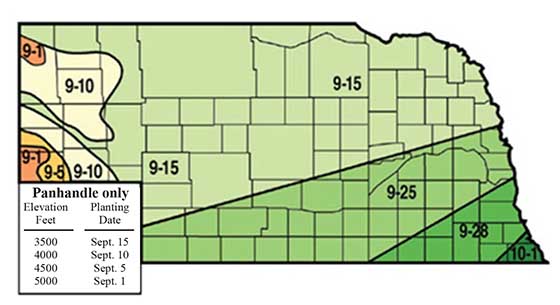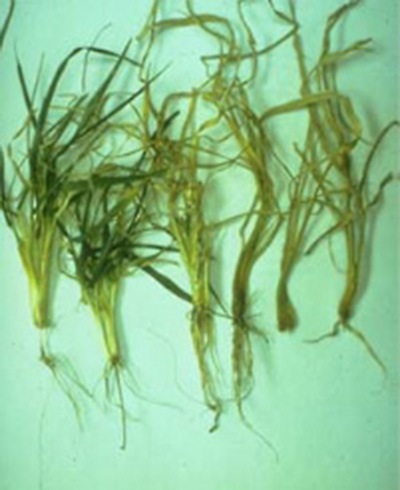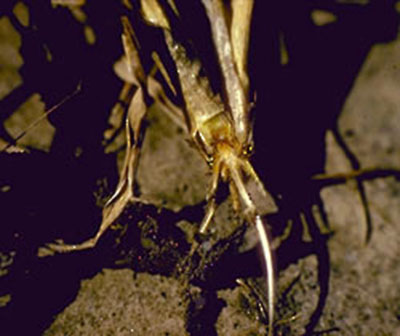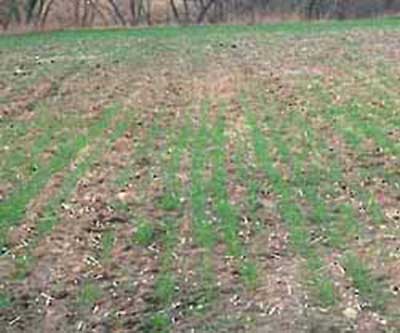G1097
Root and Crown Rot-Winterkill Complex of Winter Wheat
The root and crown rot-winterkill complex is discussed, including the nature of the complex, symptoms, control, and management rationale.
Bo Liu, Extension Plant Pathologist
Robert N. Klein, Extension Cropping Systems Specialist
Stephen N. Wegulo, Extension Plant Pathologist
- Nature of the Disease Complex
- Should I Leave or Destroy the Winter Wheat Crop?
- Conservation Tillage and No-till
- Crop Insurance and Farm Service Agency
- Acknowledgments
|
Root and crown rot of winter wheat is an interrelated disease complex caused by the interaction of infection of roots and crowns by Bipolaris sorokiniana and/or Fusarium graminearum and harsh winter conditions. It is an insidious, persistent, and inconspicuous disease complex that reduces wheat yields each year. In extreme cases, entire fields or large areas within fields are killed. The ultimate effect is loss of stands, poor plant vigor, reduced yield, and lower grain quality. The stages of crown and root rot are shown in Figure 1.
Nature of the Disease Complex
Winter Injury
The growth and development of winter wheat is limited by temperature, growing degree days, available water, soil fertility, and disease and pest outbreaks. Besides the cap placed on yield by climate and soils, limitations are imposed by weather-related episodes such as winterkill, freeze injury, drought, or heat stress at critical times of plant development. Although the wheat plant compensates for many of these stresses, each can lower yield.
Low temperatures kill winter wheat plants by injuring the crown. When adequately hardened, crowns can tolerate temperatures down to -9 to -11°F. The hardening process is the key to a plant’s ability to withstand low temperatures. Plants that develop several tillers because of early seeding remain more vulnerable to low temperatures than those seeded later. Plants in the three-leaf or four-leaf stage with good root systems are in the best position to survive the winter in the Central Great Plains. These plants are subject to desiccation due to cold, dry winds and a lack of adequate snow cover. Soil- and seed-inhabiting fungi parasitize weakened plants and limit their ability to recover in the spring. Winter wheat that remains green into December because of a long growing season may be severely injured by a rapid temperature drop in early winter. Temperatures that fluctuate from below 0°F to above 70°F during winter undoubtedly affect winter hardiness. Each time a plant breaks dormancy during winter, it loses some of its winter hardiness.
Root and Crown Rot
A healthy root system is critical to wheat’s ability to tiller and produce large heads. Healthy roots are needed to support growth; when diseased, they fail to deliver the appropriate balance of nutrients, water, and growth factors during the early stage of growth and development. This results in the failure of tiller buds to activate or causes the formation of small leaves and heads on the main stem and on tillers already initiated. Crown and root diseases cause a reduction in the number and size of heads and/or a loss of stands.
Prolonged moisture stress coupled with relatively high soil temperature in the fall enhance early disease development on the roots. The detrimental effects of a loose seedbed, soil moisture deficiency, lack of an insulating snow cover, ice, and sustained low temperatures become apparent in the spring when affected wheat fields fail to green up uniformly. These factors predispose the plants to infection by the root- and crown-rotting fungi.
Distribution and Symptoms
|
The prevalence of root and crown rot or winterkill varies within fields and across the major wheat growing areas of the state. The disease complex is most common in western Nebraska where drought and strong winter winds predispose seedlings to root and crown rot, but it can be equally severe anywhere in Nebraska where stress conditions prevail.
Symptoms of root and crown rot of winter wheat may first appear on the roots and subcoronal internode as early as September, but usually develop in late November. Small brown to black lesions occur on the primary and secondary roots. These lesions, which may develop on any part of the root, vary in length, ranging from less than 1/8 inch to over 1 inch.
Diseased crowns are brown to dark brown (Figure 2) in contrast to the white color of healthy crowns. Wheat crowns rot to a greater or lesser degree, depending on the stage and severity of disease development. Plants will not recover from severe damage to the crown even with optimal weather conditions for growth. Plants with severely damaged crowns fail to develop new crown roots to meet the need of the growing plant for water and soil nutrients. Those with moderate root and crown damage tiller sparsely and yield less than plants with healthy roots and crowns.
Individual fields affected by root and crown rot contain scattered pockets of dead and dying plants (Figure 3). Affected areas often follow terrace ridges or occur on exposed slopes. Other fields show damage uniformly over much of the crop. To diagnose the disease, remove suspected seedlings, wash free of soil, and examine for the presence of dark brown lesions and nonfunctional roots with few or no new roots initiating from the crown. Split the crowns at the base of the stem with a sharp knife or a razor blade to detect rot.
Symptoms on the aerial parts of wheat associated with root and crown rot include wilting, stunting, and chlorosis. Preemergent and postemergent damping-off of wheat seedlings caused by root and crown rot fungi is generally not a serious problem in Nebraska.
Management
|
Cultural practices greatly affect the incidence and severity of root and crown rot. They influence environmental stress which, in turn, affects the susceptibility of the plant and the viability and virulence of the pathogen.
The following are recommendations for managing root and crown rot.
1. Plant winter wheat at the recommended date. Early planting favors good plant establishment that helps control wind erosion; however, heavy fall growth can seriously deplete soil moisture reserves. In the spring, root and crown rot abounds in early planted wheat because of drought stress. Late planting conserves moisture, but if there is too little soil protection due to insufficient plant growth, residues, or surface roughness, serious wind erosion and winter injury will result.
A guideline for determining the best seeding date to minimize this disease was developed for western Nebraska based on elevation (Figure 4). With 4,000 feet as the base elevation and September 10 as the base date, each 100-foot difference in elevation means a one day difference in planting time. The higher the elevation, the earlier the best planting date; the lower the elevation, the later the best planting date.
 |
| Figure 4. Suggested seeding dates for winter wheat in Nebraska. |
2. Plant the recommended varieties for your area. Know the winter hardiness of a variety before you plant.
3. Plant in a firm, mellow seedbed. Place seed firmly in moist soil and cover with sufficient soil to prevent rapid drying. If the soil surface is dry at planting, use a hoe drill instead of a disc drill so placement of the winter wheat seed is into firm, moist soil. The openers must have proper tension to ensure that wheat seed is planted deep enough, especially in the tractor tracks. Depth of soil over the seed should be 1 to 1 1/2 inches in medium to fine textured soils, and 2 inches in coarse textured soils. Soil aggregates should be fine enough to provide good soil-seed contact, but not so fine that rain will puddle the silt and cause crusting, or wind will drift the soil.
4. Control weeds in summer fallow land. Weeds deplete soil moisture, hastening drought stress, which in turn, predisposes the plants to root and crown rot.
5. Rotate crops. This is an important method to reduce loss caused by root and crown rot. A fallow period also may reduce the pathogen level in soil. A two- or three-year rotation with non-susceptible crops, such as legumes and hay crops, will reduce the severity of root and crown rot.
6. Provide balanced soil nutrition. Phosphorus helps winter wheat survival, which stimulates root growth and tillering. Phosphorus application is necessary if soil testing indicates low phosphorus level.
7. Consider treating seed with an appropriate fungicide before planting. Seed treatments can control many diseases, depending on the seed treatment and rate used. (See the following list and Table I.) Most seed treatments need to be applied with seed-treating equipment as uneven or incomplete seed coverage may not provide the desired control.
Common Bunt |
Fall Season Powdery Mildew Fall Season Leaf Rust Fall Season Septoria Leaf Blotch Fusarium Seedling Blight |
Common Root Rot (Cochliobolus spp.) Fusarium Root Rot Fusarium Crown Rot Take-All Pythium Damping-off |
| Table I. Fungicide seed treatments commonly used to manage root and crown rot.1 | |
| Trade Name2 | Fungicides |
| Dividend® | Difenoconazole + metalaxyl-M |
| Dividend® XL RTA Dividend® Extreme Incentive™ RTA® |
Difenoconazole + mefenoxam |
| Agsco Double R™ Nuzone Flo Pro IMZ |
Imazalil |
| Maxim® 4FS | Fludioxonil |
| Maxim® XL | Fludioxonil + mefanoxam |
| Rancona™ Apex | Ipconazole |
| Rancona® Pinnacle | Ipconazole + metalaxyl |
| Proceed™ Concentrate | Prothioconazole + tebuconazole + metalaxyl |
| Stamina® | Pyraclostrobin |
| Raxil® MD Dyna-Shield® |
Tebuconazole + metalaxyl |
| Raxil® MD Extra | Tebuconazole + metalaxyl + imazalil |
| Sativa™ M | Tebuconazole + metalaxyl |
| Charter® |
Triticonazole |
| Charter® F2 Charter® + Acquire® |
Triticonazole + metalaxyl |
| Charter® PB | Triticonazole + thiram |
| Charter® F2 + Stamina® | Triticonazole + pyraclostrobin + metalaxyl |
| 1These products normally are applied with other seed treatment products. 2This list is presented for information only and no endorsement is intended for products listed or criticism meant for products not listed. Consult the product label before buying and using a specific fungicide. Read and follow all label directions and restrictions. |
|
Should I Leave or Destroy the Winter Wheat Crop?
This question always comes up in spring where fields have marginal stands. Before deciding, growers will want to consider the estimated yield, soil moisture for replacement crops, other cropping options, partial field loss, government programs, soil erosion, and effect on rotations.
Determining Winter Survival
Occasionally growers wish to estimate wheat yield in the winter, prior to active wheat growth. The following method can be used to determine if dormant wheat plants are alive and likely to resume active growth in the spring:
- Remove the top 3 inches of soil containing the plant crown (typically located 1 to 2 inches below the soil surface).
- Thaw the samples and warm to room temperature.
- Remove soil from the roots and wash with cool water to remove attached soil.
- Cut off roots below the crown and fall growth to within 1 inch above the crown.
- Rinse the crowns with cool water.
- Place 10 wet crowns in a labeled plastic bag, inflate the bag and tie shut.
- Place the bags in a lighted room, but not in direct sunlight.
- Check the crowns in two days, rinse with cool water, and reinflate the bag.
- After four days, the crown should show about 2 inches of new growth.
- Plants that are not growing after six days should be considered dead when estimating survival.
- Some plants may grow poorly and develop molds that live on dead or injured plants.
Remember, winterkill can be a very localized event, so select sample areas carefully and don’t try to extrapolate results too widely.
Estimating the Yield Potential of Winter Wheat
Estimating the yield of winter wheat in late winter or early spring is difficult. Winter wheat can compensate for early loss; that is, if one yield component is affected, another may make up part of the yield loss. A yield estimate assumes that soil moisture and soil fertility are adequate, the recommended planting date was used, weeds and insects are controlled, and plant diseases are not a factor. Tables II and III provide an estimate of the potential of winter wheat yields based on healthy plants per foot of row in various row spacings.
| Table II. Estimated potential yield in bushels of winter wheat based on five tillers/plant, 22 seeds/head, and 16,000 seeds/pound. | ||||||||||||
Number of healthy plants/foot of row |
||||||||||||
Row spacing |
1 |
2 |
3 |
4 |
5 |
6 |
7 |
8 |
9 |
10 |
11 |
12 |
Inches |
Bushels/acre |
|||||||||||
6.0 |
10 |
20 |
30 |
40 |
50 |
60 |
— |
— |
— |
— |
— |
— |
7.5 |
8 |
6 |
24 |
32 |
40 |
48 |
56 |
65 |
— |
— |
— |
— |
9.0 |
7 |
13 |
20 |
27 |
33 |
40 |
47 |
54 |
60 |
— |
— |
— |
10.0 |
6 |
12 |
18 |
18 |
24 |
30 |
36 |
42 |
48 |
54 |
60 |
— |
12.0 |
5 |
10 |
15 |
20 |
25 |
30 |
35 |
40 |
45 |
50 |
55 |
60 |
14.0 |
4 |
9 |
13 |
17 |
22 |
26 |
30 |
34 |
39 |
43 |
47 |
52 |
| Table III. Estimating winter wheat yield after stem elongation for the Nebraska Panhandle.* | |||||||||||||
Number of tillers/foot of row |
|||||||||||||
Row spacing | 10 |
15 |
20 |
25 |
30 |
35 |
40 |
45 |
50 |
55 |
60 |
65 |
70 |
Inches |
Bushels/foot of row |
||||||||||||
6.0 |
22 |
34 |
49 |
56 |
67 |
79 |
90 |
101 |
112 |
— |
— |
— |
— |
7.5 |
18 |
27 |
36 |
45 |
54 |
63 |
72 |
81 |
90 |
99 |
108 |
— |
— |
9.0 |
15 |
22 |
30 |
37 |
45 |
52 |
60 |
67 |
75 |
82 |
90 |
97 |
105 |
10.0 |
13 |
20 |
27 |
34 |
40 |
47 |
54 |
61 |
67 |
74 |
81 |
88 |
94 |
12.0 |
11 |
17 |
22 |
28 |
34 |
39 |
45 |
51 |
56 |
62 |
67 |
73 |
79 |
14.0 |
10 |
14 |
19 |
24 |
29 |
34 |
38 |
43 |
48 |
53 |
58 |
63 |
67 |
| *To estimate yield in other Nebraska locations, multiply the table result by one of the following factors: southwest Nebraska, 0.9; central and south central Nebraska, 0.75; southeast Nebraska, 0.75. | |||||||||||||
Yield potential should be adjusted for seeds per head and seed size. For information on seed sizes of winter wheat refer to the University of Nebraska–Lincoln Extension Fall Seed Guide (EC103), which is updated and published annually. Winter wheat ranges from about 12,000 to 20,000 seeds per pound.
Soil Moisture for Other Crops
If soil moisture is limited, most replacement crops will fail unless rainfall is timely and above average. If the winter wheat is destroyed where fallow is practiced, the best alternative is to fallow the land using herbicides to maintain crop residues and reduce wind and water erosion. Plant the replacement crop on land that would have been fallowed. The key here is to check which land has more stored soil moisture. Also check with the appropriate government agency before implementing any change.
Partial Field Loss
In a questionable stand of winter wheat, avoid the temptation to “thicken up” the field with spring wheat. If the spring wheat makes a crop, the result would be a mixture of winter and spring wheat classified as mixed grade. The best alternative, if weather permits, may be to plant winter wheat in late winter. Plant by March 1 (a week earlier in southeast Nebraska and a week later in the Panhandle) for vernalization to occur. Check with your seed dealer for the vernalization requirements of the variety you’re planting. In most of Nebraska, except the northern areas, winter wheat seeded in late winter is more likely than spring wheat to make a crop, by about 20 bushels.
Conservation Tillage and No-till
Conservation tillage and no-till farming practices have been adopted in much of Nebraska to conserve soil moisture, lower labor inputs, and reduce soil erosion. Conservation tillage and no-till may be associated with a possible change in root and crown pathogens. Research in other states has suggested that large amounts of residues on the soil surface, in some cases, may favor pathogen survival between crops. However, the most limiting factor in wheat production in Nebraska is water; conservation tillage and no-till conserve water from rainfall, snow, and irrigation. Crop residue can reduce crop water use significantly, whereas tillage can increase water evaporation, reduce seedbed firmness, dry the topsoil, bury protective residues, increase winter kill, and may increase root and crown rot. Moreover, other management practices such as a glyphosate application in chemical fallow or pre-plant weed management may increase root and crown rot.
Crop Insurance and Farm Service Agency
Before destroying any winter wheat or planting replacement crops, check with your crop insurance provider and the appropriate government agency.
Acknowledgments
The authors would like to recognize the contributions of the original authors of this publication: John E. Watkins, Ben Doupnik Jr., and Eric D. Kerr, former UNL extension plant pathologists.
This publication has been peer reviewed.
Visit the University of Nebraska–Lincoln Extension Publications website for more publications.
Index: Plant Diseases
Wheat
1992, 2006, Revised January 2013


